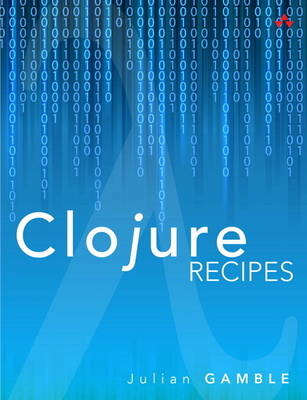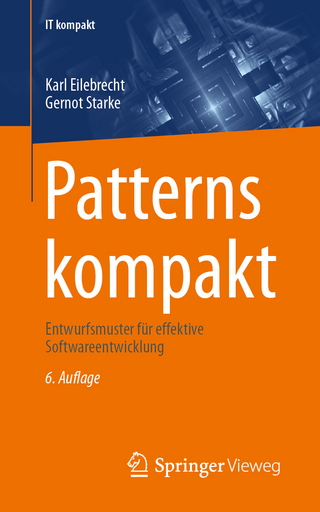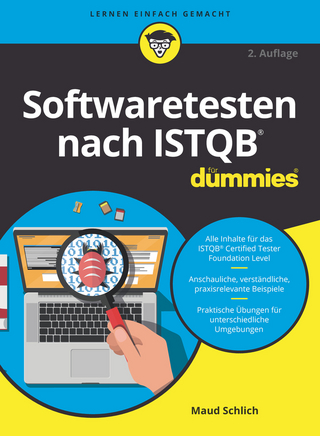
Clojure Recipes
Addison-Wesley Educational Publishers Inc (Verlag)
978-0-321-92773-6 (ISBN)
- Titel ist leider vergriffen;
keine Neuauflage - Artikel merken
Developers are discovering the exceptional power of Clojure’s functional programming model to quickly solve problems in domains ranging from social networking to Big Data. Clojure is fast and efficient—ideal for rapid prototyping and lean development. And it is highly expressive and extremely extensible, which makes Clojure one of today’s leading tools for software innovation. Since it targets the Java Virtual Machine, Clojure also leverages the Java platform’s maturity and enormous ecosystem.
Clojure Recipes is a wide-ranging, up-to-date “code recipe book” for this increasingly popular language. With practical and self-contained examples, author Julian Gamble illuminates Clojure’s key features and best practices, showing how to solve real-world problems one step at a time. Focusing on Clojure 1.7 and higher, Gamble fully reflects recent enhancements that ensure you’re getting the most up-to-date code for your project.
Gamble first walks you through the essential steps required to set up your Clojure development environment, from setting up the Leiningen build tool to packaging Clojure for Java EE environments. He then shows you how to build both basic and advanced REST servers, before turning to a wide range of increasingly sophisticated applications.
In this book you will find
- Innovative Clojure code for diverse web, security, administration, and development tasks, from log reading and app monitoring to software testing
- Detailed instructions for using concurrency primitives, writing new DSLs, simplifying cloud database development, and more
- “Learn by doing” projects, which offer practical experience with Clojurescript, Storm, Pedestal, Datomic, and other advanced tools
- Coverage of using Clojure with Cascalog 2.0 to write complex Hadoop queries with minimal code
The breadth and quality of Gamble’s examples make Clojure Recipes uniquely valuable both to developers who are exploring Clojure for the first time and to those already using it in production
Julian Gamble is a software engineer who has worked in the financial services industry for more than a decade. When he's not enabling billions of dollars to orbit the globe, he writes and presents on all things software-related at juliangamble.com/blog. He lives in Sydney, Australia.
Preface xv
About the Author xix
Chapter 1: Starting Your Project with Leiningen 1
Assumptions 1
Benefits 1
The Recipe–Windows 1
The Recipe–Mac 3
Conclusion 4
Postscript–Setting Up a JDK on a Mac 4
Postscript–Setting Up a JDK on Windows 6
Chapter 2: Packaging Clojure for a Java EE Environment 11
Assumptions 11
Benefits 11
The Recipe–Common 11
Conclusion 14
Postscript–Setting Up Tomcat on a Mac 14
Postscript–Setting Up Tomcat on Windows 16
Chapter 3: Creating a REST Server in Compojure 19
Assumptions 19
Benefits 19
The Recipe–Code 19
Testing the Solution 20
Notes on the Recipe 22
Conclusion 23
Chapter 4: Creating a REST Server with Liberator 25
Assumptions 25
Benefits 25
The Recipe–Code 25
Testing the Solution 28
Notes on the Recipe 29
Context 32
Conclusion 33
Chapter 5: A REST Client in ClojureScript 35
Assumptions 35
Benefits 35
The Recipe–Code 36
Testing the Solution 38
Notes on the Recipe 39
Conclusion 40
Chapter 6: A Simple JSON Server 41
Assumptions 41
Benefits 41
The Recipe–Code 41
Testing the Solution 44
Notes on the Recipe 45
Conclusion 47
Chapter 7: A Simple Server Using the Pedestal Framework 49
Assumptions 49
Benefits 49
Context 49
The Recipe–Code 50
Testing the Solution 52
Notes on the Recipe 53
Conclusion 54
Chapter 8: A Stock Ticker on the Pedestal Framework Server 55
Assumptions 55
Benefits 55
The Recipe–Code 55
Testing the Solution 60
Notes on the Recipe 62
Conclusion 67
Chapter 9: Simplifying Logging with a Macro 69
Assumptions 69
Benefits 69
The Recipe–Code 70
Testing the Solution 72
Notes on the Recipe 74
Conclusion 76
Chapter 10: Extending the Compiler with a Macro 79
Assumptions 79
Benefits 79
The Recipe–Code 79
Testing the Solution 81
Notes on the Recipe 82
Conclusion 85
Chapter 11: Simplifying Datomic Syntax by Writing a DSL 87
Assumptions 87
Benefits 87
The Recipe–Code 88
Testing the Solution 97
Notes on the Recipe 103
Conclusion 106
Chapter 12: Reading the SASS DSL and Generating CSS with Clojure Zippers 107
Assumptions 107
Benefits 107
Outline–Features of SASS 107
The Recipe–Code 109
Testing the Solution 121
Notes on the Recipe 122
Conclusion 133
Chapter 13: Introduction to Cascalog 135
Assumptions 135
Benefits 135
The Recipe–Code 135
Testing the Solution 137
Notes on the Recipe 139
Conclusion 141
Chapter 14: Cascalog and Hadoop 143
Assumptions 143
Benefits 143
The Recipe–Code 143
Testing the Solution 145
Conclusion 146
Postscript–Setting Up Hadoop on a Mac 146
Postscript–Setting Up Hadoop on a Windows Machine 147
Chapter 15: Loading a Data File into Cascalog 149
Assumptions 149
Benefits 149
The Recipe–Code 149
Testing the Solution 150
Conclusion 151
Chapter 16: Writing Out a Data File with Cascalog 153
Assumptions 153
Benefits 153
The Recipe–Code 153
Testing the Solution 154
Notes on the Recipe 155
Conclusion 155
Chapter 17: Cascalog and Structured Data 157
Assumptions 157
Benefits 157
The Recipe–Code 157
Testing the Recipe 159
Notes on the Solution 160
Conclusion 161
Chapter 18: Loading Custom Data Formats into Cascalog 163
Assumptions 163
Benefits 163
The Recipe–Code 163
Testing the Recipe 175
Notes on the Solution 176
Conclusion 177
Chapter 19: Connecting to Datomic from Your Application 179
Assumptions 179
Benefits 179
The Recipe–Code 179
Conclusion 188
Chapter 20: Getting Started with Storm 189
Assumptions 189
Benefits 189
The Recipe–Code 190
Testing the Recipe 192
Notes on the Recipe 192
Conclusion 195
Chapter 21: Getting Started with JMS in Clojure 197
Assumptions 197
Benefits 197
The Recipe–Code 197
Testing the Recipe 200
Notes on the Recipe 200
Conclusion 201
Chapter 22: Integrating Storm and JMS 203
Assumptions 203
Benefits 203
The Recipe–Code 203
Testing the Recipe 213
Notes on the Recipe 213
Conclusion 215
Chapter 23: A CSV Reader 217
Assumptions 217
Benefits 217
The Recipe–Code 217
Testing the Solution 219
Notes on the Recipe 219
Conclusion 220
Chapter 24: Detecting Errors with a Log Monitoring Application 221
Assumptions 221
Benefits 221
The Recipe–Code 221
Testing the Solution 223
Notes on the Recipe 223
Conclusion 224
Chapter 25: Bundling Clojure as an Ant Plug-in 225
Assumptions 225
Benefits 225
The Recipe–Code 225
Testing the Recipe 227
Notes on the Recipe 228
Conclusion 228
Postscript–Installing Ant on a Mac 229
Chapter 26: Bundling Clojure as a Maven Plug-in 231
Assumptions 231
Benefits 231
The Recipe–Code 231
Testing the Recipe 239
Notes on the Recipe 240
Conclusion 240
Chapter 27: Integrating Clojure by Scripting Web Tests 241
Assumptions 241
Benefits 241
The Recipe–Code 241
Testing the Recipe 242
Notes on the Recipe 243
Conclusion 243
Chapter 28: Monitoring Availability with a Website Status Checker 245
Assumptions 245
Benefits 245
The Recipe–Code 246
Testing the Recipe 247
Notes on the Recipe 249
Conclusion 249
Appendix A: Debugging Macros 251
Assumptions 251
Benefits 251
The Recipe 251
Conclusion 259
Index 261
There’s something for everyone here. . . . You can pick up and read this book and build an industry-standard system in a weekend: It has everything you need to get started with a new project. I also found it helpful in reviewing the structure of existing projects.
Timothy Pratley, developer
| Erscheint lt. Verlag | 29.10.2015 |
|---|---|
| Verlagsort | New Jersey |
| Sprache | englisch |
| Maße | 179 x 229 mm |
| Gewicht | 452 g |
| Themenwelt | Mathematik / Informatik ► Informatik ► Software Entwicklung |
| Schlagworte | Clojure • Clojure; Programmieren; Funktionale Programmierung; Concurrent Programming; Java • Clojure (Programmiersprache); Einführung • Funktionale Programmiersprache • Java Virtual Machine (JVM) • Nebenläufige Programmierung |
| ISBN-10 | 0-321-92773-7 / 0321927737 |
| ISBN-13 | 978-0-321-92773-6 / 9780321927736 |
| Zustand | Neuware |
| Haben Sie eine Frage zum Produkt? |
aus dem Bereich


